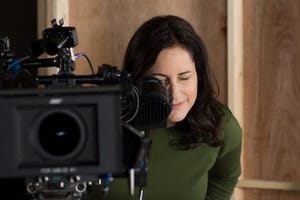
Imagine a Full Picture
I personally dislike when people say, “I want to see something that I’ve never seen before.” We’ve heard a lot of love songs, but I wouldn’t tell anyone that I’ve heard a love song before, so I don’t want to hear their love song. If you have a topic that people could quickly label as familiar, how are you going to emphasize the way that you’re approaching this topic differently? And why is it important that you tell this story this way? That’s what a lot of people get wrong about how they present their project — it’s not just “this story,” but it’s also “this way.” This can be tricky for documentaries, especially if you’re applying for early funding, because a lot of it is discovered in the making of the film on location with your subjects, or in the edit bay when you sort of write the film in post.
People think they can tell a grant maker what has already happened with a film, and that the rest will just magically take care of itself. But a grant reviewer wants to know that this person or team has the ability to imagine a full film. Show them that you have the capacity to envision and communicate a full story, and be transparent about what you know already and what you’re anticipating will unfold in front of your camera, even if you don’t really know that full story will be. As you start to win your first grants, you’ll see that sometimes you win the grant, and then the project changes. That’s OK.
Part of what’s interesting with grant writing is that a grant application is like a snapshot in the evolution of your project. Think of it like a photograph of a field in one season. In the next season, it’s the same place, but looks different. Be honest about elements you’re unsure about as you write each application, but also use your writing and work sample to demonstrate your creativity and your ability to be imaginative.
Also read: Advice for Indie Filmmakers: Avoid These 4 Mistakes
Sometimes you will write something in your grant application that hasn’t happened yet, or is a hopeful outcome for the story you’re telling. And then you make the film, and lo and behold, your film told the story that way.
Perfect Harmony
With your work sample, you definitely want to gravitate toward emotional moments — moments that grant makers can easily imagine becoming scenes, or parts of scenes, with compelling characters. A sizzle reel is not a good idea, because again, you’re not just showing what the story is, but how the story is going to be told. Do whatever you can to communicate how your film will feel to watch — which a sizzle reel does not show. Grant readers are trying to imagine from your work sample what the full film will be like, and so if the work sample is a real mismatch stylistically or tonally from what you want to make in the end, you’re doing yourself a disservice. Grant readers don’t want to see tons of beautiful shots in a row, if your film is not going to be tons of beautiful shots in a row.
You also want harmony between what’s on the page and what’s in the work sample. If they’re not in perfect harmony, there’s usually a way you can explain this in the section that says, “Describe what we’re seeing in the work sample.” But do your best to have your words in the proposal reflect what people are seeing in the sample, and vice versa.

Unrest, a 2017 doc which Alysa Nahmias produced, receiving funding from an number of organizations including Sundance Documentary Fund, Chicken & Egg, and the Harnisch Foundation. Courtesy of Shella Films
Unveiling the Curtain
Don’t believe that your application will be given sustained or special attention. Your grant application’s first audience is usually a junior staff member or a freelance reviewer — perhaps a moviemaker, or someone else working in the nonprofit art space. This person usually reads a lot of applications, and your application could be the first, 12th, or the 30th of the day. You want to grab people’s attention.
If the grant project scores well in the first stage, it will be read again, by another reviewer, who could be a senior staff member or internal reviewer. Some grants are approved internally by a small group of people, while other grant makers bring in an outside panel to review the top candidates. That’s when people are going to be having a conversation about your film.
I’ve been on the panel reviewing for grants, and I’ve seen that someone must really believe in a project for it to get past the final phase. I was in a panel discussion once, and we could pick four out of around 12 in the final round. Interestingly, the ones that everyone agreed were simply “good” ended up being the ones that didn’t get selected for funding. The ones that got picked were the ones that people fought for, or which fit into the organization’s grant mandate in innovative ways. Moviemakers think somehow that there’s some mathematical or objective way that these things get decided, but when you get in the room, you understand that’s not the case; it’s subjective to a large extent.
Knowing your audience makes it easier to deal with rejection, because you know that it’s not necessarily that your project wasn’t great — it just didn’t make the final cut. An organization is figuring out what its final slate of projects is going to look like, and trying to balance geographical mandates, artist’ ages and backgrounds, subject matter, and stage of production. All of these factors and more come into play. The more you can be clear about where your project is and what it is, the faster the panelists can focus on the things that most matter to you.
Grant making is an act of matchmaking, and some projects are grant darlings. You have to find the right organization, the right grant for your project, and the right timing. Some films find matches easily, but it doesn’t necessarily mean that they’re better films, or even that their applications were better written.
Also read: Film Distribution Vet Liz Manashil Explores the Future of a Post-Pandemic Film Industry
Keep at it. Just because you got a rejection once, doesn’t mean that you won’t get a grant the next time, especially if your project has changed in a substantial way. You can also be realistic about the best type of funding for your film. Very few projects are funded entirely by grants, and many films are better suited for equity financing, co-productions, or crowdfunding.
“Core Audience” VS. “Target Audience”
Just as you must have an audience for your grant application, you also must have an audience for your movie. For Unrest, a documentary I produced, a large core audience consisted of people who had the disease that’s represented in the film. We also had target audiences. We wanted doctors, nurses, members of Congress, local lawmakers, and scientists to see the film, because they’re the ones who can enable the film to make an impact in the world.
There are a lot of other ways to think about audience: in terms of age, gender, and geography, for example. All come into play with both your core audience and target audiences.
Leveling the Playing Field
The playing field is not level when it comes to grants (or much else in this industry). Those at an advantage include experienced moviemakers, people who are college-educated, people who have time to write grants, people who can pay for application fees, and people for whom English is a first language. Grant makers may try to work against this as readers and evaluators, but it’s impossible to ignore that the playing field is not level. That’s part of why the documentary community — the grant makers and those who have a direct line to them — have real work to do to decolonize documentary, to be inclusive in determining who makes decisions and who receives grant funding, and to deliberately work to include voices of people who haven’t been included in this space before, or who might appear to be riskier choices for grant funding. We must rethink how we define “risky.”
—As told to Caleb Hammond
Share:

